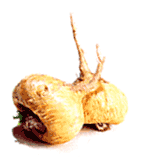
Lepidium meyenii
Lepidium meyenii (maca) is an herbaceous biennial plant of the crucifer family native to the high Andes of Peru. It was found at the Meseta of BomBom close to Junin Lake in the Andes. It is grown for its fleshy hypocotyl (a fused hypocotyl and taproot), which is used as a root vegetable and a medicinal herb. Its Spanish and Quechua names include maca-maca, maino, ayak chichira, and ayak willku.
Botanical characteristics
The first westerner to describe this species was Gerhard Walpers who named it Lepidium meyenii in 1843. In the 1990s, Gloria Chacon made a further distinction of different species. She considered the widely cultivated natural maca of today to be a newer domesticated species, L. peruvianum. Most botanists today doubt this distinction, however, and continue to call the cultivated maca L. meyenii. The Latin name recognized by the USDA also continues to be Lepidium meyenii. Debate is a still ongoing about the correct nomenclature and whether the distinction between meyenii and peruvianum is botanically correct.

Plant
Plants, also called green plants, are multicellular eukaryotes of the kingdom Plantae. They form an unranked clade Viridiplantae (Latin for green plants) that includes the flowering plants, conifers and other gymnosperms, ferns, clubmosses, hornworts, liverworts, mosses and the green algae. Green plants excludes the red and brown algae, the fungi, archaea, bacteria and animals.
Green plants have cell walls with cellulose and obtain most of their energy from sunlight via photosynthesis by primary chloroplasts, derived from endosymbiosis with cyanobacteria. Their chloroplasts contain chlorophylls a and b, which gives them their green color. Some plants are parasitic and have lost the ability to produce normal amounts of chlorophyll or to photosynthesize. Plants are also characterized by sexual reproduction, modular and indeterminate growth, and an alternation of generations, although asexual reproduction is also common.
Precise numbers are difficult to determine, but as of 2010, there are thought to be 300–315 thousand species of plants, of which the great majority, some 260–290 thousand, are seed plants (see the table below). Green plants provide most of the world's molecular oxygen and are the basis of most of the earth's ecologies, especially on land. Plants that produce grains, fruits and vegetables form mankind's basic foodstuffs, and have been domesticated for millennia. Plants are used as ornaments and, until recently and in great variety, they have served as the source of most medicines and drugs. The scientific study of plants is known as botany, a branch of biology.

Plantà
The plantá (which comes from the verb to plant; in Valencian, plantà) is the act of erecting a Falla or bonfire monument, in the Fallas or the Bonfires of Saint John, festivals held respectively in March and June in different localities of the Community of Valencia (Spain).The plantà is currently considered the exact moment when the falla or bonfire is completely finished and ready to be visited, with all its “ninots” (human figures made of combustible materials, such as cardboard or wood, which has a critical or mocking nature), posters and a variety of features (lights, matted grass, interpretive signs...).
In the Fallas of Valencia, the plantá takes place on March 15, when all the Falla monuments must be positioned correctly. The reason is that the jury appointed by the Central Fallera committee has to go to the next day to assess the falla. Formerly, the plantà began and ended the same day but, due to the complexity of the monuments and the fact that the makers of Fallas are responsible for several Fallas monuments at the same time, it usually begins a few days before. The burning of the Falla or cremá is carried out four days later, on the night of March 19.
Plant (disambiguation)
A plant is a living organism that generally does not move and absorbs nutrients from its surroundings.
Plant may also refer to:
In manufacturing and engineering
In media and entertainment
In names

Macaé
Macaé (Portuguese pronunciation: [mɐkɐˈɛ]) is a municipality located in the Brazilian state of Rio de Janeiro, 180 km northeast of the state capital. Its population was recorded as 206,748 in 2010 and its municipality covers an area of 1,216 km².
Macaé is generally considered to be the centre of the Brazilian offshore petroleum industry and it is often referred to as "Cidade do Petróleo" ("City of Petroleum"). The Brazilian state-controlled oil company Petrobras has many facilities within the town. Macaé is one of the fastest-growing cities in Brazil, with a growth of 600% within the last 10 years.Benedito Lacerda Airport is served by scheduled flights and concentrates operations to off-shore platforms.
Other economic activities in the city include tourism and fishing. These two sectors were very important for the city's revenues before the 1980s. The city has a growing reputation for high-quality technical education and training.
Although the city has some touristic potential, the lack of investiments on this area makes its growth to be very small. Its most famous beaches are Cavaleiros and Pecado. The interior of the municipality has small rural towns such as Sana and Frade.
MACA
MACA or maca can mean:
Places
Geography
Outer space
People
MACA
See also

Cerro Macá
Cerro Macá is a stratovolcano located to the north of the Aisén Fjord and to the east of the Moraleda Channel, in the Aysén del General Carlos Ibáñez del Campo Region of Chile. This glacier-covered volcano lies along the regional Liquiñe-Ofqui Fault Zone. It has erupted basalt.
Cerro Macá has a summit elevation of approximately 2,300 m above sea level.
See also
Footnotes
References
Podcasts:

Latest News for: maca (plant)
- 1
